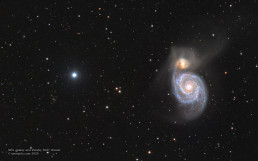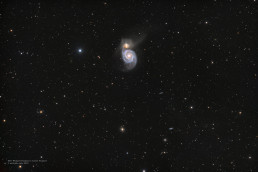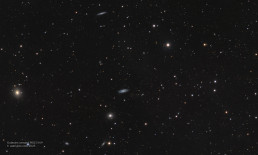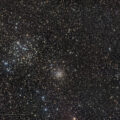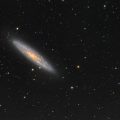Messier 51, the Whirlpool Galaxy, is known for several reasons, but perhaps not all of you know that it was the first galaxy to be classified as a spiral galaxy. The galaxy and its companion, NGC 5195, are easily observed by amateur astronomers using binoculars only. But the larger instrument we use, and the darker sky we have, the more features we will be able to notice (however, the Zwicky 6057 galaxy cluster will remain invisible).
Whirlpool Galaxy was discovered on October 13, 1773, by Charles Messier while hunting for objects that could confuse comet hunters. Messier was determined to create a catalog of all comet-like targets, and the new galaxy landed in this catalogue at number 51, but the name “Whirlpool” was established much later. The spiral structure of the galaxy was discovered by William Parsons using a 1.8-meter telescope at Birr Castle, Ireland – M51 was the first “nebula” to be known to have those features. But these “spiral nebulae” were not recognized as galaxies until Edwin Hubble was able to observe cepheid variables in some of them, and the actual distance estimation was done.
The Whirlpool Galaxy lies at a distance of about 24 million light-years. It has two prominent spiral arms, and the pronounced structure of these arms is believed to be the result of interaction with its companion galaxy, NGC 5915. This companion may have passed through the M51 disk about 500 million years ago. As a result of this process, a variety of tidal features have been created, and the largest is the so-called Northwest plume, which extends out to 140,000 light-years from the galaxy center. NGC5195 itself is a dwarf galaxy, also called M51b, while the Whirlpool Galaxy is M51a. M51b was discovered by Pierre Mechain on March 20, 1781.
The Whirlpool galaxy is an extremely satisfying astrophotography target due to its high surface brightness and well-defined features. The subtle glow around the galaxy pair is best enjoyed through long-exposure photography. I captured data for the image above in April 2025. There were several quite transparent nights, and even under my suburban sky, the final result after processing is quite impressive (in last year’s best nights, my sky brightness is about 19.5 mag/arcsec2). My current imaging setup contains an APS-C format camera and a 130mm refractor, so the field of view is a bit too large for a single galaxy’s imaging. That is why I was able to capture both M51 with NGC5195, but also a bigger area around with several distant galaxies and also galaxy clusters. In the first image crop, you may notice Zwicky 6057 galaxy cluster – the small bunch of yellow dots in the left part of the frame. This cluster is located about 2 billion light-years away. And the second enlargement below contains the NGC5169 galaxy about 125 million light-years away, and a very distant and faint galaxy cluster to the right of NGC5169.
Image technical data: Date: April 2025 Location: Nieborowice, Poland Telescope: TS Photoline 130/910 Corrector: TS FF/FR 0.8x Camera: QHY268M Mount: EQ6 Guiding: ASI290MM + Evoguide ED50 Exposures: LRGB 460:150:100:120 minutes Conditions: Bortle 6, transparency and seeing medium-good
